Q&A – Ask Neil: August 21, 2025
(Please read these instructions carefully.)
Before you post your question, please look at recent issues to see if someone else has already asked it. You might find your answer there.
How to submit your question…
(Note: You may need to allow a pop-up window to come up in order to get the link for sending your photo(s). If you have already submitted your question and didn’t see the pop-up window, please click here.)
• Click the link provided below to post your question. After you submit your question, a new window will pop up giving you the address to which you can e-mail a SHARP, HIGH-RESOLUTION PHOTO to accompany your question. Please DO NOT SEND THUMBNAIL PHOTOS in case I need to zoom in to see things.
• Click here to post your question.
• Please ONLY POST YOUR QUESTION ONE TIME. We can only accept a set number of questions each week, and when we get duplicates it costs other people their chances.
• One question per reader, please.
• Please use this only for posting questions – not for standard emails.
• Watch for your answer in the following week’s e-gardens.
• I choose those of greatest general interest. For example, plant IDs seldom make the cut.
• I must have your first name or initials.
• I must have your city or county. (Texas is a very large state.)
Important favor: I’ve been covered up so far this year with questions about live oaks losing chunks of bark. Rather than continuing to answer the same questions weekly, I’d ask that you look back to previous issues. You’ll find several replies that I’ve posted. Thanks!
QUESTION 1
WHICH IS MORE IMPORTANT IN TIMING FALL APPLICATION OF PRE-EMERGENTS, SOIL TEMPERATURE OR TIME OF MONTH?
Question: What is more important when putting down pre-emergent in early fall? Is it the soil temperature, or is it the time of the month (September)? Reggie T., Hewitt, McLennan County.
Answer: Cool-season grassy weeds such as rescuegrass, annual ryegrass, and annual bluegrass (Poa annua) germinate once there is moisture and when temperatures drop into the low 60s. As long as it’s hot and dry, it doesn’t matter whether it’s early or mid-September. That’s why the prolonged summer weather much of Texas has had in the past several years slowed germination of the weeds. But once the first cold front accompanied by rain blew through, the weeds started growing. The farther south you go in Texas, the later that happens. Where you are in the Waco area your application date would normally be September 5-15, but it could shift a slight amount dependent on cold fronts and rain.
QUESTION 2
CAN YOU SPRAY IMAGE FOR NUTSEDGE IN A FLOWERBED SAFELY?
Question: Can you spray Image for nutsedge in a flowerbed without being meticulous not to get it on other plants in your bed? Amanda H., Fairview.
Answer: Remember that as soon as you apply the Image product for nutsedge with a hose-end sprayer or watering can with many gallons of water to make sure it covers the designated square feet, your next instruction is to water it into the soil deeply. That means that you would be washing it off the leaves of your “good” plants (as well as off the leaves of the nutsedge). It does its work by being absorbed by the roots and taken into the conducting system of the nutsedge plants. So, the answer to your question is, yes, you can apply it. However, I would still be careful as to the amount of the herbicide you got around the good plants’ roots.
QUESTION 3
WHY DOES MY RIVER BIRCH LOSE LEAVES ON AND OFF ALL SUMMER?
Question: I don’t understand why my river birch loses leaves right after a rain or right after I water plants beneath it three days in a row. Do they get on some type of cycle? Caryn H., Garland.
Answer: River birch trees are rarely used in landscapes in the Metroplex because of the struggles they face with high temperatures and low humidities every North Texas summer. They simply can’t pull water through their systems rapidly enough to meet their needs, so they shed foliage to compensate. They’re also susceptible to borers. When those insects attack, they cut off the supply lines for water from the roots up to the leaves, so that compounds the problem. If they’re involved, you would be seeing tiny exit holes from their tunnels up and down the trunks and branches. Lacking those, it’s probably just the temperature and humidity issues.
QUESTION 4
WHY DO FOUR PITTOSPORUMS PLANTED IN MAY LOOK LIKE THIS TODAY?
Question: I planted four pittosporum plants in May 2025. They look like this. What has caused this? Is there anything I can do to help them recover? Susie S., Abilene.
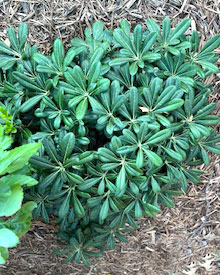
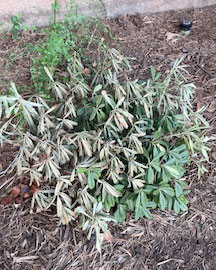
Answer: This has not been caused by an insect or disease. I suspect the plants have gotten too dry at one or more times. It looks like they were watered just after what plant physiologists call the “permanent wilting point.” That’s the point at which the plant cannot recover.
In all candor, pittosporums are a risk in Abilene. You’re too far north for them to be dependable through the winters. Temperatures in the low 20s and certainly in the teens can kill the plants. You would be better served with dwarf hollies, dwarf nandinas, dwarf junipers or other better-adapted plants. Let a Texas Certified Nursery Professional guide you in your choice of replacements.
QUESTION 5
WHY ARE LEAVES FALLING FROM SUNSHINE LIGUSTRUM?
Question: I have a grouping of three Sunshine ligustrums. Two appear diseased. One is healthy. I see no evidence of spider mites and I do not think water is an issue. The branches do not break when bent, but the leaves fall off when shaken. Please help. Michael G., Tarrant County.
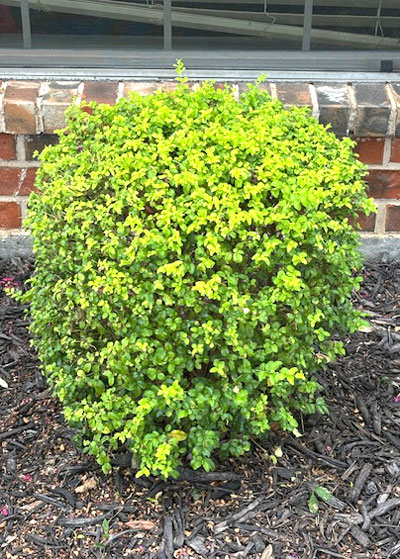
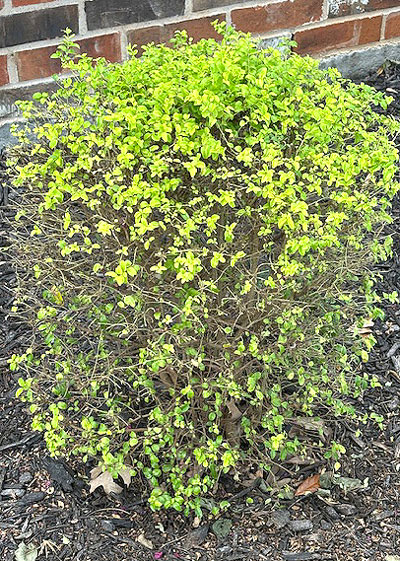
Images clickable for larger views.
Answer: Sunshine ligustrums behave erratically. I’ve mentioned before here how unstable the color is – that they revert to solid green very often and that the green growth must be kept removed by hand. Powdery mildew can also be a problem with them, and that may be involved with your plants. Excessive pruning weakens the plants. That may also be going on here. I do have to admit that it looks like the plants might have gotten too dry at one point or another, although I do note what you said.
QUESTION 6
WHAT IS THIS MYSTERY PERENNIAL THAT HAS EMERGED FROM WITHIN MY SUMMER PHLOX?
Question: My summer phlox is doing wonderfully. Thanks for recommending it years ago. However, coming up beside it is a mystery perennial that I believe I planted back then as well. I have completely forgotten its name. What is it? I’ll need to transplant one to a new location this winter. Steve R., Arlington.
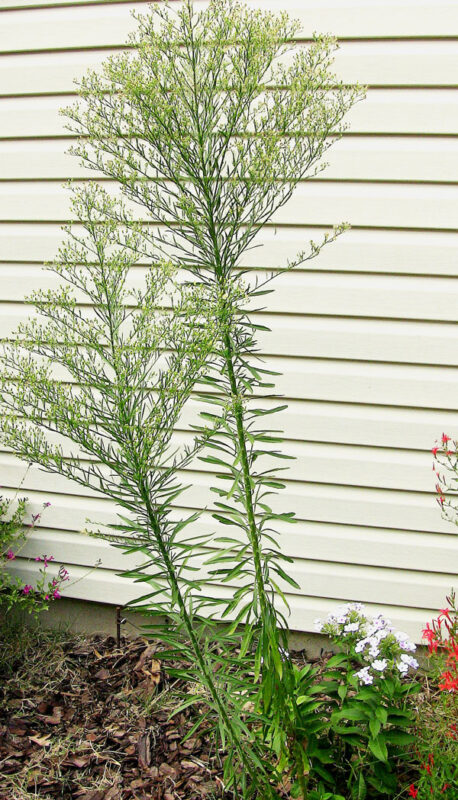
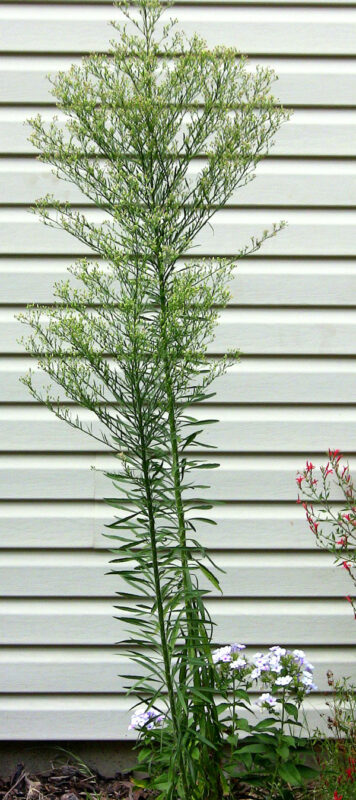
Images clickable for larger views.
Answer: This plant is like a song that sticks in your mind. Several people have asked about it – a retired pastor at church – and now I see it everywhere I go. This is horseweed (Conyza Canadensis), sometimes called “mare’s tail.” Its spikes of tiny white flowers (not especially showy) will quickly give rise to tens of thousands of fluffy seeds that will waft through the neighborhood like an unwelcome noise. Your plant is well on its way. Better get it cut out before it populates half of Arlington. I wish I had better news.
QUESTION 7
ARE THESE RUNNERS FROM “GOOD” GRASS OR WEEDS?
Question: Are these runners from good grass or weeds? My lawn is a mixture of St. Augustine, bermuda, and weeds. The two photos are from different areas, so they may be different things. David Y., Rowlett.
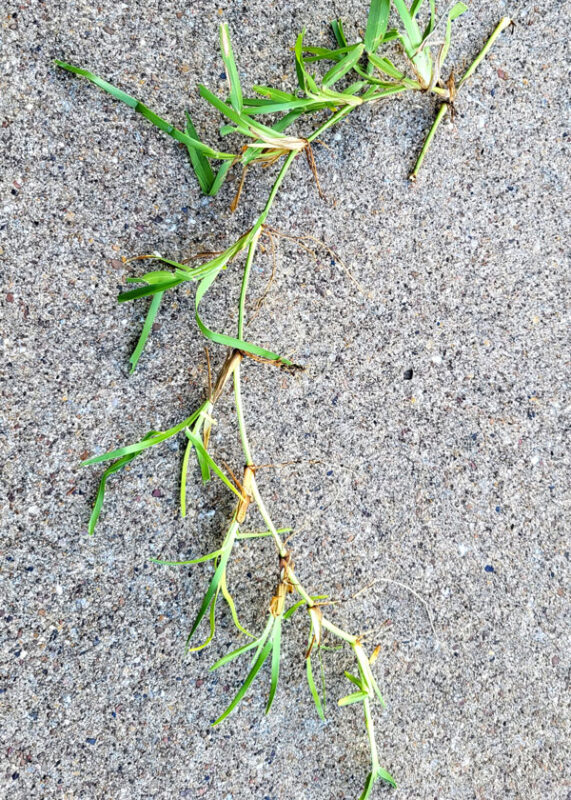
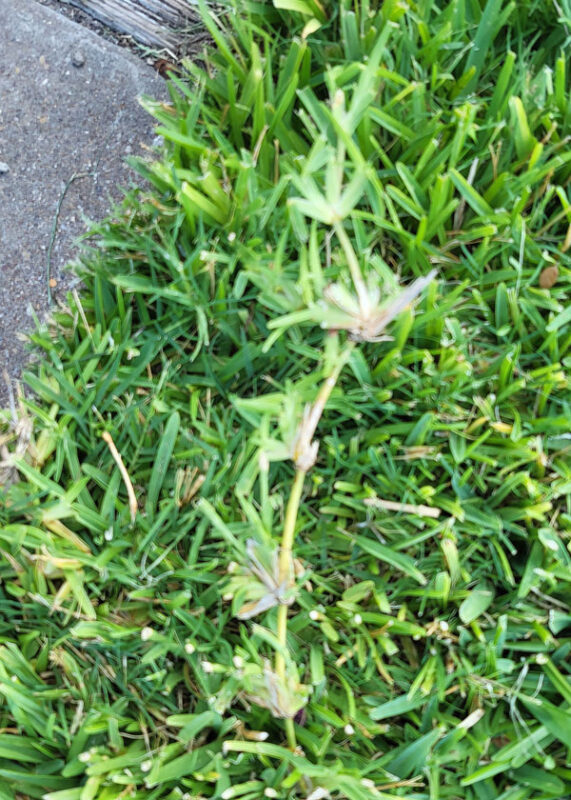
Images clickable for larger views.
Answer: These are both runners from St. Augustine. One looks like it might have been clipped off where it had grown out over the concrete. It looks like it got very hot and just too dry. On the other hand, the one over the turf is exhibiting what we see with St. Augustine fairly frequently. It produces runners that fail to “peg down” to the soil. They have blackened primordial roots that can’t function, so they dry up and die. I normally just lift them with my shoe and mow them off the next time across the lawn. They’re of very little concern in the long run.
